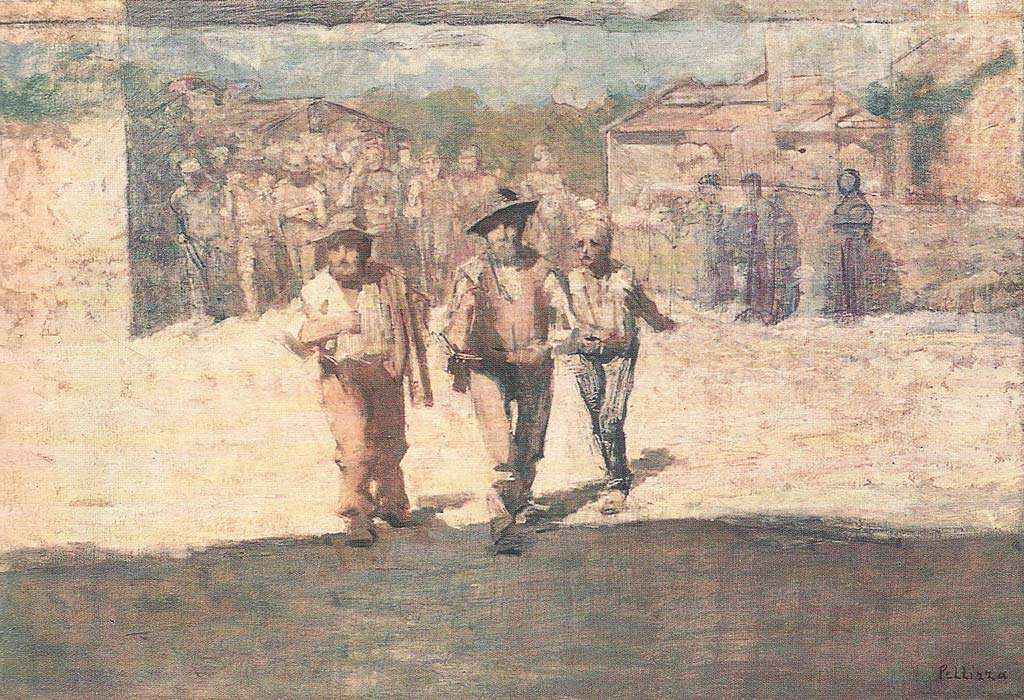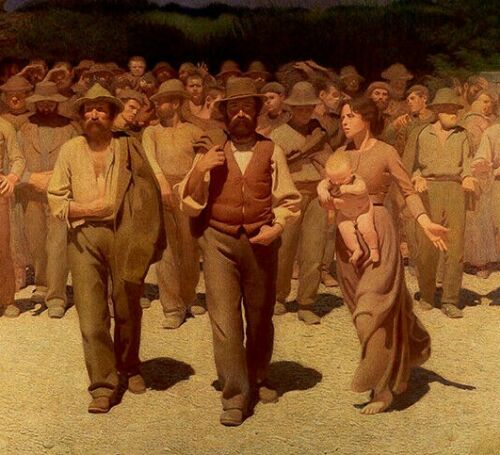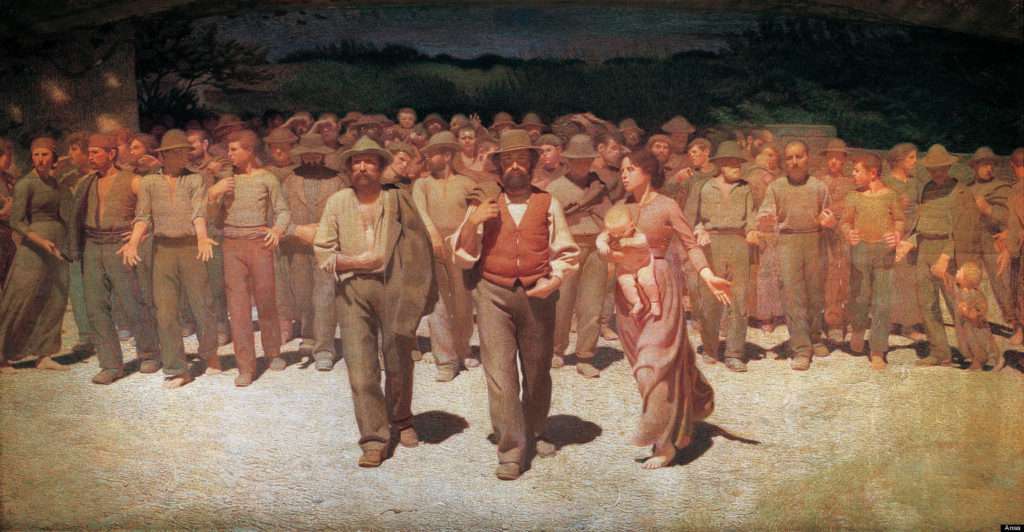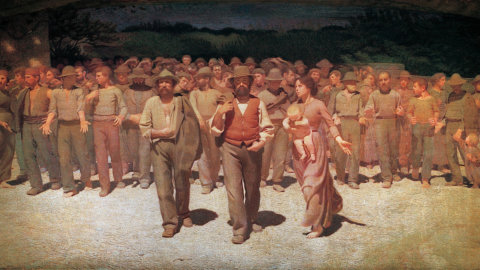For this occasion of 1 May, the work of Pelizza da Volpedo is exhibited in Florence, exactly where the artist stayed while attending the Academy of Fine Arts, under the teaching of Giovanni Fattori.
Il Fourth State, will remain in Florence on loan from Milan until the end of June and brings to the heart of the city government a work that is a powerful symbol of the history of the workers' struggle for the affirmation of their rights. The march of the laborers by Pellizza da Volpedo asking for bread and dignity brings with it not only the cultural value but becomes an event, a performance that will have a resonance that goes beyond the artistic and expressive values properly so-called contained in the canvas: the Fourth State thus it becomes a message that links art with the social, economic and working spheres. A valuable loan that lays the foundations for a lasting and significant collaboration between the cities of Florence and Milan.
The work The Fourth Estate the result of a long creative period that lasted 10 years and which represents the world of work, it has belonged to the Municipality of Milan since 1920 and has been exhibited at Palazzo Marino, at the Gallery of Modern Art and since 2010 it has been kept at the Museo del Novecento in Milan.
The first sketch of the work on the theme of the strike (Hunger ambassadors) dates back to 1891 and was already set in the square of his native Volpedo.

Later the artist came to realize the version la River today at the Pinacoteca di Brera. Pellizza, but dissatisfied decided to take care of a new canvas The Path of the Workers, which reduced the number of figures in the background but increased the characters in the foreground making them more monumental and realistic. The Fourth Estate it was presented for the first time in 1902 at the international exhibition of modern decorative art in Turin.

The painting is a response to the bloody events in Milan in 1898 (when, during popular uprisings, General Bava Beccaris fired on the crowd causing a massacre) and is deeply influenced by the artist's humanitarian socialism. The people in the foreground appear in a peaceful protest aimed at a better future.
After the unsuccessful debut of 1902, this work will still be talked about during the workers' strikes after the victory of the radical socialists in the political elections of November 1919 in Milan and again after the publication of the first catalog in 1935 where the work is described as " two men and a woman with a child in their arms”.

Fourth State di Giuseppe Pellizza da Volpedo – work it represents
the claims of the workers of the late nineteenth century.
With The Fourth Estate the concept of figuration in art ends and an era under the sign of protest begins. A painting that resolutely expresses the crowd marching towards a future of progress and redemption.
"Since I had the first idea of my picture, and it has been several years already, I have never felt half-hearted in admiration for these good and strong and intelligent workers whom I have tried to glorify. I owe it to this state of mind that I was able, overcoming the many difficulties I encountered, to bring the painting to the point it currently is… In the times when every manifestation of genius is used to consider the work with the false lens of parties of the free man runs the risk of being misunderstood”. (letter to an acquaintance of 28 September 1900
Dario Nardella, Mayor of Florence"The silent and compact march of the farm workers of the Quarto Stato is more contemporary and current than ever. In a period of great uncertainty and difficulty like the one we are experiencing, Pellizza da Volpedo's masterpiece reminds us that work is an irreplaceable social engine, an instrument of freedom and not only economic independence, but also the identity and personal of each individual. In Milan we are very attached to this work, because it puts the people, work and rights at the centre. Purchased by the citizens in 1920, thanks to a fundraiser promoted by the socialist mayor Emilio Caldara, the painting was exhibited at Palazzo Marino, at the Gallery of Modern Art and since 2010 it has been at the Museo del Novecento. On the occasion of May XNUMXst, Labor Day, we are happy to be able to share the message of strength and hope that this procession releases with the city of Florence and the visitors of the Salone dei Cinquecento. The collaboration started with the exhibition on the "Three Pietàs" continues to be fruitful thanks to this iconic work, which closes the nineteenth century and opens the art of the short century. And it will continue over the next few years with projects focused on the reciprocal loan of works of art and joint cultural initiatives, with a profound symbolic value."
Giuseppe Sala, Mayor of Milan "In the wake of the cultural collaboration launched by the exhibition 'Le Tre Pietà', still ongoing at the Museo dell'Opera del Duomo in Florence, the Municipality of Milan, which proudly keeps it in its civic heritage, has decided to grant a temporary loan in Florence, on the occasion of Labor and Workers' Day, the Quarto Stato by Giuseppe Pellizza da Volpedo. The result of a long and complex design process, this work is an epigone of pointillist painting, an icon of Italian art at the turn of the XNUMXth and XNUMXth centuries. The representation of the peaceful march of the laborers who advance or proceed compactly towards the viewer gives new meaning to the conception of art, which from this point on also becomes an instrument of denunciation and a vehicle of hope. If ideally it constitutes the hinge between the XNUMXth and XNUMXth centuries, artistically the Quarto Stato is a timeless masterpiece and, at the same time, one of the fullest works of their era, a representation par excellence of the aspiration of every worker to a dignified and more right. This project, shared between Milan and Florence also in terms of curatorship, will allow Florentine citizens and the many tourists who visit the city the exceptional opportunity to admire an extraordinary work, deepening from a historical and artistic point of view a fundamental junction in Italian history and European: the transition from agricultural to industrial society, which substantially changed every aspect of life in our country, generating instances destined to change its face definitively."
Giuseppe Pelizza was born in Volpedo (in the province of Alessandria) in 1868.
His parents were small landowners and, since he had shown a particular talent for drawing from an early age, they educated him in the best Italian academies. At the Brera Academy he will be a pupil of Francesco Hayez, then he studied in Rome, Florence, Bergamo and finally Genoa, but he was always dissatisfied with the training received, which led him to travel continuously until he made a trip to Paris on the occasion of the Universal Exposition of 1889. In 1891 he exhibited at the Milan Triennale and in 1895 he participated in the 1st Venice Biennale with the works Procession e Portrait of Mrs. Sofia Abbiati. Finally in 1901 concludes his masterpiece, the work to which he had dedicated many years of study and effort: the Quarto Stato, the work destined to become an icon of the social struggle of the proletariat. Especially after the publication in "Avanti della Domenica" in 1905.Giuseppe Pellizza da Volpedo he committed suicide in 1907.
Sunday 1st May, on the occasion of Metropolitan Sunday, for all residents of the Metropolitan City of Florence it will be possible to visit the work of Giuseppe Pellizza da Volpedo in Palazzo Vecchio for free. Admissions available subject to availability.





